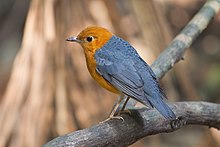Orange-headed thrush
| Orange-headed thrush | |
|---|---|
 |
|
| ssp. innotata | |
| Scientific classification | |
| Kingdom: | Animalia |
| Phylum: | Chordata |
| Class: | Aves |
| Order: | Passeriformes |
| Family: | Turdidae |
| Genus: | Geokichla |
| Species: | G. citrina |
| Binomial name | |
|
Geokichla citrina (Latham, 1790) |
|
| Synonyms | |
|
Zoothera cinerea |
|
Zoothera cinerea
The orange-headed thrush (Geokichla citrina) is a bird in the thrush family.
It is common in well-wooded areas of the Indian Subcontinent and Southeast Asia. Most populations are resident. The species shows a preference for shady damp areas, and like many Zoothera thrushes, can be quite secretive.
The orange-headed thrush is omnivorous, eating a wide range of insects, earthworms and fruit. It nests in trees but does not form flocks.
The male of this small thrush has uniform grey upperparts, and an orange head and underparts. The females and young birds have browner upper parts.
This species was first described by John Latham in 1790 as Turdus citrinus, the species name meaning "citrine" and referencing the colour of the head and underparts. It has about 12 subspecies.Rasmussen and Anderton (2005) suggest that this complex may consist of more than one species.
The following table summarises selected physical measurements for those subspecies for which the data is available.
The orange-headed thrush breeds in much of the Indian Subcontinent, including Bangladesh, India and Sri Lanka, and through Southeast Asia to Java. Its habitat is moist broadleaved evergreen woodlands, with a medium-density undergrowth of bushes and ferns, but it also utilises bamboo forests and secondary growth. Z. c. cyanotus also occurs in large gardens and orchards.
This species is often found in damp areas, near streams or in shady ravines. It occurs between 250–1830 metres (825– 6040 ft) in the Himalayas and up to about 1500 metres (5000 ft) in Malaysia, Thailand and Java. Z. c. aurata is resident between 1000–1630 metres (3300–5400 ft) on Mt Kinabalu and Mt Trus Madi, northern Borneo. Some of the subspecies are completely or partially migratory; their wintering habitat is similar to the breeding forests, but more likely to be at lower altitudes.
...
Wikipedia

